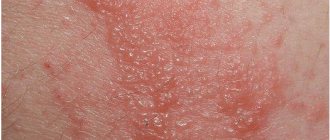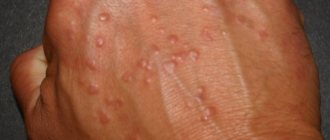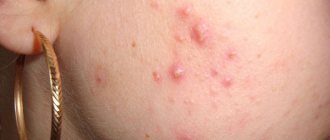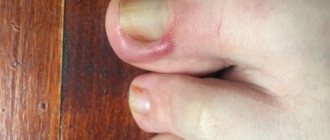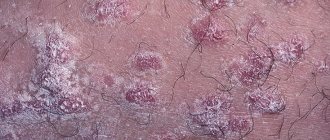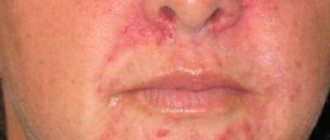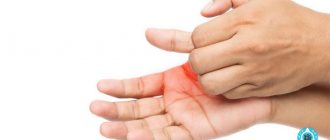A rash on the hands is a fairly common phenomenon that every person has encountered at least once in their life.
Most often, skin rashes bother children. However, in some cases they can appear not only in a child, but also in an adult. It is especially annoying if rashes appear on the skin of the face or hands - this causes not only physical, but also psychological discomfort, because it can be quite difficult to disguise a rash on the face, and you have to hide your hands from others.
In addition, rashes are often accompanied by unpleasant symptoms such as itching and burning. And as a result of scratching the affected skin, sores appear on it.
Causes of rash on hands
Before starting treatment for rashes, it is necessary to accurately determine the cause of their appearance, because the method of therapy directly depends on the source of the urticaria. Depending on why the rash appeared on the hands, it can be of varying duration and appearance. Thus, inflammation of the skin can manifest itself in the form of blisters, blisters, ulcers, or simply red spots.
The most common causes of skin rashes are:
- Lack of vitamins. Vitamin deficiency most often manifests itself as a lack of ascorbic acid, and the red dots that appear are the result of the fact that capillaries often burst due to its deficiency.
- Blood diseases. This cause of rashes on the hands is life-threatening. But the difficulty is that the person feels well and besides the rash, practically nothing bothers him. As a rule, when blood functions are impaired (in this case, when the number of platelets decreases), small rashes cover the body. Sometimes bruises of unknown origin appear on the skin, most often on the legs. The greatest itching is observed in those places where the skin is pinched by items of clothing (socks, belt, bra). If the necessary measures were not taken in a timely manner, the rash may spread to the mucous membrane of the eyes and oral cavity. Therefore, if within a few days it was not possible to establish the reason why the red rash appeared on the hands, you should immediately consult a doctor.
- Hormonal disbalance. This cause of skin rashes most often occurs in adolescents during puberty, in women during menstruation and during pregnancy.
- Insect bites (mosquitoes, ticks, bedbugs). In some people they cause absolutely no reaction, while in others, each bite that appears is very itchy and the area of the skin around it is profusely covered with rashes.
- Dermatitis (allergy). Most often, it is an allergic reaction that leads to skin rashes in adults and children. Moreover, an allergy can be not only to food or medicine, but also be the result of a weakened immune system, and even a prolonged stressful situation. Sometimes dermatitis is hereditary. Many people develop blisters on their hands after prolonged exposure to cold or heat.
- Fungal diseases. If the fungus was not detected in time and appropriate treatment methods were not taken, then rashes on the skin of the hands and the whole body will not take long to appear.
Sometimes the cause of an itchy rash on the hands can be an infection. In this case, the person will be bothered not only by skin rashes, but also by elevated body temperature, aches, and weakness. Most often, when the origin is infectious, the rash becomes purulent in nature. Depending on the type of infection, some of the following symptoms may appear: migraine, stomach pain, upset bowel movements, runny nose, cough.
The most common infectious diseases accompanied by a rash include rubella, chickenpox, scabies and measles. Intestinal yersiniosis (acute intestinal infection) is also common. This disease occurs if a person has consumed water or food (vegetables, milk, meat) contaminated with bacteria of the genus Yersinia. Thus, an infection enters the body, and after 5-6 days, due to inflammatory processes in the gastrointestinal tract, a person develops an allergic reaction in the form of a rash, dryness and peeling, itching and swelling.
Also among the serious diseases that contribute to the appearance of skin rashes are diseases such as syphilis and psoriasis. With syphilis, the rash is red-brown in color and affects mainly the arms and legs, and then spreads throughout the body; small blisters may form under the skin. The disease is difficult to recognize in time, since rashes appear only 3-4 months after infection (sexually transmitted). Moreover, the rash may temporarily disappear and then appear again.
With psoriasis (a chronic skin disease), the skin begins to peel off profusely and itch severely. The rashes primarily affect the scalp and the bends of the limbs (elbows, knees).
Preventive actions
As soon as the rash on the hands has passed and the skin has become healthy again, it is necessary to immediately take preventive measures to prevent relapses. For this it is recommended:
- maintain hygiene;
- Avoid contact with aggressive substances without gloves;
- do not eat foods that can provoke an allergic reaction;
- in cold weather, before going outside, you need to lubricate your hands with a rich cream, and in the summer, apply sunscreen to your hands.
In addition, it is very important to promptly treat all possible diseases, the symptom of which is skin rashes.
Rashes on the hands should in no case be ignored, since they are not only not aesthetic, they attract the attention of others to the hands, but can also be the cause of quite serious diseases, the treatment of which must be high-quality and timely. Only consultation with a doctor and a competent approach to treatment can guarantee complete relief from rashes on the hands. The skin between the fingers is very delicate. Often problems with the body in adults and children are reflected in this area. If you notice peeling or redness between your fingers, you need to consult a doctor, since only he can accurately determine the root cause and select the correct treatment.
Types of dermatitis
There are a great variety of allergens of various origins, and depending on them, the types of allergies. Thus, the following types of dermatitis are distinguished:
- Contact dermatitis. This allergy is characterized by the appearance of rashes on the outside of the palm, with red spots with blisters covering the skin on and between the fingers. And when they burst, painful ulcers remain in their place. The skin becomes dry, cracks appear, and inflammation occurs. The disease is accompanied by severe itching and sometimes swelling.
- The cause of contact (allergic) dermatitis is the skin's reaction to touching a specific irritant. An allergen can be anything: household chemicals (detergents, washing powder, bleach), cosmetics, personal hygiene products. People who have very sensitive skin are most prone to contact dermatitis: it is they who most often develop a rash on their hands in the form of red dots. Some women's hands become inflamed even from contact with low-quality jewelry. In children, a rash on the back of the hand is often a consequence of contact with animals (cats, dogs): in this case, the resulting dermatitis is an allergic reaction to fur.
- Atopic dermatitis. This type of allergy occurs precisely from eating food containing an allergen. Most often, an allergic reaction occurs to sweets (chocolate, honey), milk, seafood and exotic fruits (pineapples, citrus fruits). However, sometimes atopic dermatitis can be the result of taking a certain drug, often antibiotics.
Usually the rash affects not only the palms, but also the bends of the elbows. Blisters may appear on the skin.
How to treat rashes on hands at home?
Treatment should be carried out depending on the underlying cause of the skin rash:
- For blood disease . With such a cause of skin rashes, immediate qualified medical assistance is required, because the disease itself is very serious and is fraught with consequences, even death. But sometimes, in order for the skin to stop breaking out, the patient just needs to significantly diversify his diet and drink a complex of vitamins. This is what the doctor should identify.
- For insect bites . To relieve inflammation, the bitten area should be treated with a special ointment, which can be purchased at the pharmacy. Such gels have a cooling effect and have a calming effect on inflamed areas of the skin. The main thing with bites is not to scratch the affected area of the skin, then the rash will disappear on its own. However, some people may develop a severe allergic reaction - in this case, it is important to immediately seek medical help.
- For an infectious disease . If there is any reason to believe that the rash appeared as a result of an infection, then in no case should you self-medicate - the wrong approach to treatment can lead to serious consequences, and the patient’s condition can sharply worsen. You need to be examined by an experienced doctor and pass all the tests, on the basis of which it will be possible to establish an accurate diagnosis. You should not delay going to the hospital, as certain types of infection require urgent hospitalization.
- For contact dermatitis . First of all, it is necessary to exclude all skin contact with the allergen (cosmetics, household chemicals). In most cases, after eliminating the irritant, the skin itself recovers quite quickly: it stops itching, pain goes away, and swelling disappears. But if dermatitis has become acute, then eliminating the allergen alone will not be enough. Anti-inflammatory gels and ointments, as well as allergy pills (suprastin, tavegil), will come to the rescue. It’s just necessary to coordinate their use with the supervising doctor, so as not to cause even more harm. For example, there are ointments and gels that cannot be used to treat the skin if, in addition to rashes, damage has already formed on it.
- For atopic dermatitis . First of all, you need to find out what exactly led to the hives. If the allergen is a food product, then it must be urgently excluded from the diet. If an allergy appears after taking a specific medication, you should stop taking it and, if possible, replace it with another analogue drug. As a rule, atopic dermatitis disappears after eliminating the allergen. But in its advanced form it is treated with ointments and tablets. Therefore, if, after eliminating allergens, the red rash on the hands does not disappear, you should visit a dermatologist. After examination and tests, the doctor will prescribe the appropriate course of treatment.
- For a fungal disease . Antibiotic tablets and antifungal ointments, which must be used to treat the affected areas of the skin, will help get rid of the disease.
It is often quite difficult to determine the causes of skin rashes on your own. Sometimes a complete examination of the body is necessary to identify them. Especially if the rash is a consequence of a serious illness. Therefore, you should not neglect the help of doctors, because any disease is easier to prevent than to deal with the consequences. However, if at the moment it is not possible to see a doctor, then you can undertake some treatment methods yourself at home.
So, if the rash on your hands itches very much, then to relieve the itching you can use cold compresses from decoctions of medicinal herbs. The best way to relieve inflammation is a series. Chamomile and celandine also have a calming effect. It is recommended to use baths of warm decoctions of the above herbs several times a day. Some of the herbal liquid can be frozen into ice cubes and applied to inflamed areas instead of a compress. Baths with salt and calendula decoction will also help to quickly relieve inflammation and heal the skin.
Important: if as a result of a rash, sores have formed on the skin, in no case should you try to mask the rash with the help of cosmetics. This approach can significantly harm the skin.
Treatment methods
Treatment of a red rash on the hands depends entirely on the diagnosis. If it is only a consequence of another disease, then medications are prescribed to cure the underlying disease, not the symptom.
For simple relief of itching and burning:
- You can simply treat the rash with brilliant green or an antiseptic to dry the blisters; they prevent injury to the rash;
- Use a special ointment, for example, Skin-Cap or Panthenol.
The following is usually used to treat scabies:
- Sulfuric ointment;
- Ice or corticosteroid ointment can be used to relieve severe itching during treatment.
For allergic dermatitis you need:
- Find out the allergen and remove it from your life;
- You will need to reconsider nutrition, cosmetics, animals, flowers and many other substances;
- Antihistamine ointments aimed at reducing swelling and redness, such as Fenistil and Advantan, will help for treatment.
The diagnosis and treatment of a red rash should be made by a doctor, since the means used, duration and course depend entirely on the cause of the appearance.
Drug therapy
Treatment with pharmaceutical drugs is carried out over the entire affected area. Elimination of dermatological signs occurs with the help of ointments, creams, they treat the source of infection.
Prevention
It is important to understand that a person who has once encountered rashes on the hands will have a certain predisposition to this disease again. Therefore, to avoid such consequences in the future, you should adhere to the following recommendations:
- Before taking any medication, carefully read the instructions and be sure to take into account individual intolerances.
- Watch your diet. Your daily diet must include vegetables and fruits rich in vitamins. It is important to eat fish and meat. If necessary, you should take a vitamin complex. A proper diet will prevent the occurrence of vitamin deficiency.
In this case, you need to avoid foods that cause an allergic reaction. For almost every person, there is a certain food product that is contraindicated for him and as a result of which a rash appears on the hands. For some people it's sweets, for others it's fruit. To minimize the occurrence of allergies, it is better not to take risks and plan your diet wisely. You should also give up exotic dishes, giving preference to products from domestic proven producers.
- Carefully monitor the skin of your hands. It is necessary to maintain personal hygiene at the proper level, in particular, to monitor the skin of the face and the cleanliness of hands. It is necessary that each family member has individual items for hygiene procedures: his own personal towel, washcloth and soap. After visiting any public place (market, transport, toilet), you must wash your hands with soap, or, in extreme cases, wipe them with a sterile damp cloth. Important: you need to wash your hands in warm (not cold or hot) water!
- You should be careful when choosing cosmetics, avoiding expired goods and low-quality products. It is necessary to select creams specifically for your skin type. The best option is hypoallergenic cosmetics without perfume compositions. Care products such as shampoo, shower gel and soap can also provoke allergies, so when purchasing them, you should also take into account the individual characteristics of your skin.
- When working with household chemicals, you need to use rubber gloves. In this case, after removing them, your hands must be thoroughly washed with soap, then rinsed with clean water, and after drying, moisturize with a nourishing cream. If dermatitis occurs precisely from contact with rubber products, then it is recommended to wear thin cotton gloves under them.
- Sudden temperature changes have a negative impact on the skin. Therefore, it is important to protect your hands from exposure to both severe frost and direct sunlight. Both in the hot season and during the cold season, it is necessary to moisturize the skin of your hands with a nourishing cream.
- Avoid contact with street animals.
- Be careful when choosing jewelry. If women's skin is very sensitive, then you should abandon cheap jewelry and opt for products made from natural stones and high-quality metals. Although in most cases, a rash on the wrists from jewelry occurs specifically in the fair sex, in men, wearing a wristwatch with a bracelet that is not suitable for the hands can also cause pink spots to appear on them.
Taking the above measures will significantly reduce the likelihood of recurrence of skin rashes. It is important to understand that a rash in most cases signals some kind of disruption in the body. Therefore, when it appears, you should not let the disease progress by itself. Moreover, there is a risk that the rash will spread over the skin of the entire body. In addition, a small rash on the hands can be a symptom of a dangerous disease.
How to treat eczema on the hands: treatment with ointments, medications, folk remedies Chickenpox in children Streptoderma Herpes zoster in children Measles in adults
